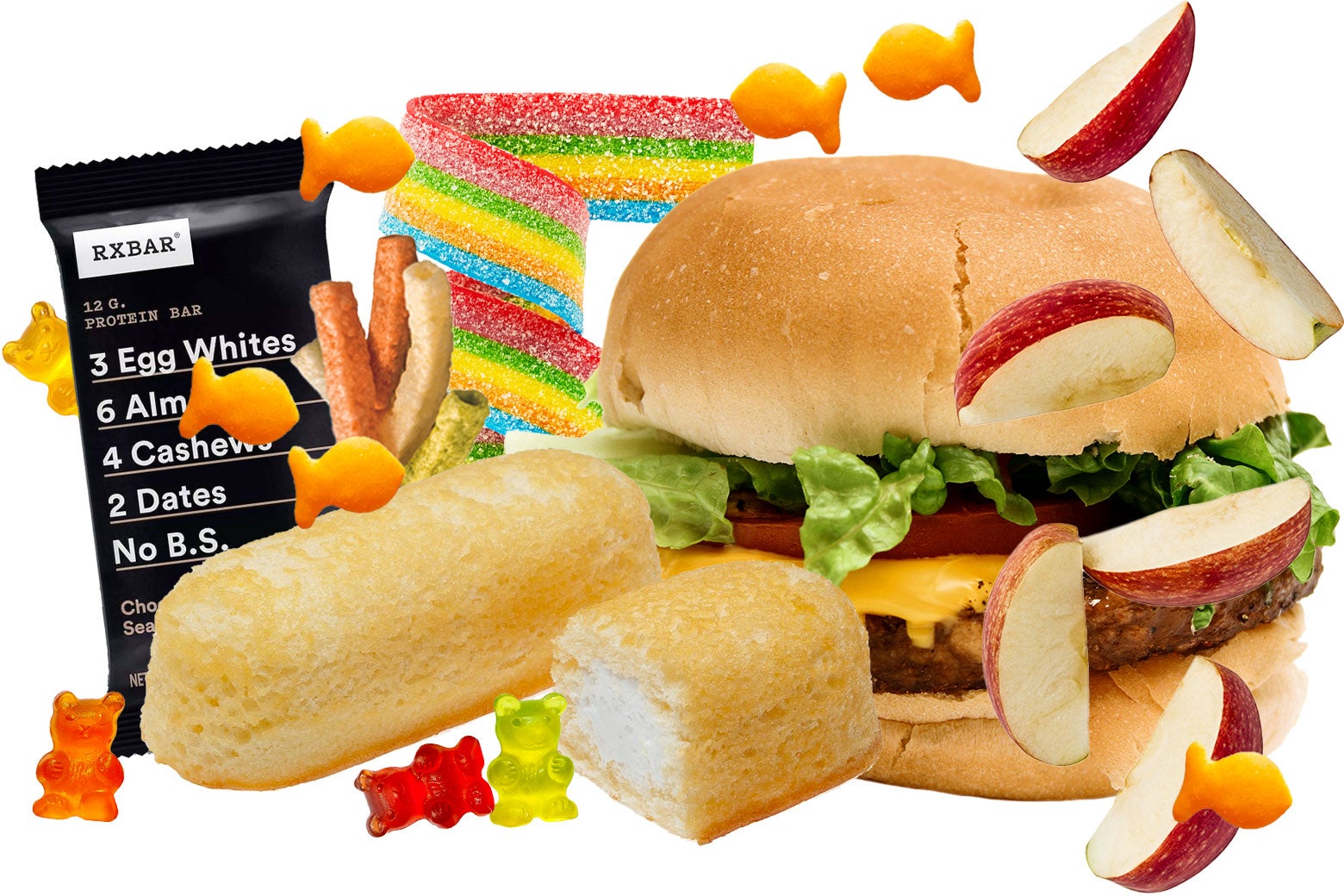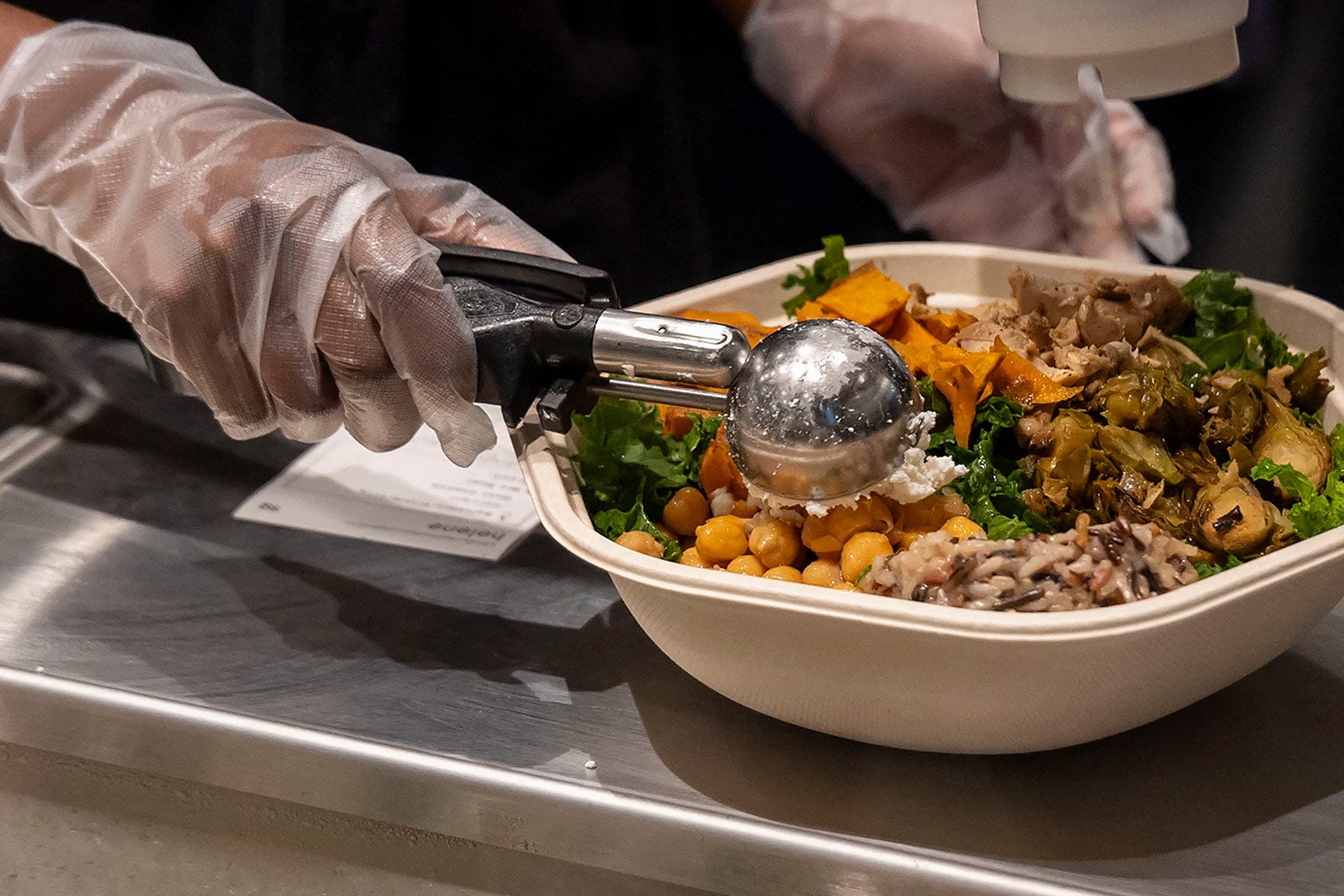The other day, I overheard a local day care provider lamenting to a parent about the avalanche of processed foods found in children’s lunchboxes—from crackers to fruit pouches to gummy bears. As the parent tsked in disapproval, an incriminating image of my own preschooler’s puffed rice cakes and parmesan crisps flashed before me. I’m a working parent with an unusually picky eater, so I routinely pack these convenient, shelf-stable foods for my 4-year-old.
Our lunchbox may not be Michael Pollan–approved, but let’s face it: Processed foods really help us make it through the scramble of the week. And Michael Pollan isn’t in my kitchen helping out in the mornings.
What I often feed my kid (and myself) are what some researchers call “ultraprocessed foods,” a capaciously defined term which can include everything from foods that are inarguably junk (Funyuns, anyone?) to whole-grain, prepackaged bread with a single artificial preservative. More than half of the American diet comes from ultraprocessed foods, which is maybe a bad thing: Observational research has correlated a diet high in ultraprocessed food to various chronic health conditions in children and adults, from diabetes to obesity to poor brain health.
Because of this troubling evidence, government health agencies and experts writing for popular audiences are sounding the alarm about ultraprocessed foods. Government experts in the U.K. and the U.S. are currently examining the evidence about the health harms of ultraprocessed foods, and their findings could shape the next national dietary guidelines. Already, national guidelines in Brazil, Israel, and other countries urge their citizens to avoid them completely. A book by the British doctor and television personality Chris van Tulleken, called Ultra-Processed People, debuted at No. 1 on the U.K. bestseller list this spring. This has all produced a flurry of scary headlines: “Beware of the Food That Isn’t Food,” “Why Ultra-Processed Foods Are So Bad for You,” “Ultraprocessed Foods Are Easy, Cheap and Could Be Killing You.”
It’s understandable if you’re tempted to throw out your protein bars and pouches of baby food and commit to a life of toting Tupperwares filled with quinoa and carrot sticks. But are ultraprocessed foods really that bad? Or is this just the latest nutritional panic?
The term “ultraprocessed food” entered the lexicon in 2009 when Carlos Monteiro, a public health researcher in Brazil, decided the food pyramid needed to be demolished. Such guidelines “are designed to encourage consumption of healthier foods, by which is usually meant those higher in vitamins, minerals and other nutrients seen as desirable,” Monteiro wrote. “What is generally overlooked in such approaches, which currently dominate official and other authoritative information and education programmes, and also food and nutrition public health policies, is food processing.” Monteiro called diets high in ultraprocessed foods “intrinsically nutritionally unbalanced and intrinsically harmful to health,” whether or not those foods are loaded with vitamins and minerals. He was inspired in part by Michael Pollan’s 2008 book In Defense of Food, which counseled readers to avoid eating anything their great-grandmother wouldn’t recognize. By focusing so myopically on nutritional content alone, Monteiro argued, health agencies were missing a big part of the picture. The sophisticated industrial processing and hard-to-pronounce chemical ingredients might really be the problem.
Soon, he and other researchers formalized these ideas into the “NOVA system,” which ranks foods not by nutritional content, but by their level of processing. At the bottom are unprocessed and minimally processed foods, such as apples, spinach, nuts, or fresh meat (all meat is at least a tiny bit processed: You can’t plate an actual chicken). Then there are processed foods and culinary ingredients. This category contains most food. Bread is processed food. Olive oil is a processed culinary ingredient. There is some grinding and smashing, heating and mixing involved to create these foods. At the top of this new food pyramid (though it’s often presented as a horizontal chart) are ultraprocessed foods, which take the number of steps and ingredients involved to the next level. They often begin with inexpensive crops like corn, soy, or wheat that are then pulverized, extruded, and transformed into substances that bear little resemblance to their original form. These creations are infused with manufactured flavors, artificial sweeteners, chemical preservatives, unusual binding agents, fruit juices derived from “concentrate,” and other additives.
Whether a food is ultraprocessed or not might be obvious when we’re talking about, say, a Twinkie. But what about yogurt? Here things get more confusing. Chobani’s zero-sugar vanilla yogurt, which contains, yes, no fat and no sugars, would be classified as ultraprocessed (ingredient list: milk, water, allulose, vanilla extract, natural flavors, tapioca flour, citrus fiber, guar gum, sea salt, stevia leaf extract, monk fruit extract, citric acid, enzyme, cultures). On the other hand, Chobani’s plain whole-milk Greek yogurt, which contains 9 grams of fat and 6 grams of sugars, would not (ingredient list: cultured milk).
And when drawing the “ultraprocessed” line, the adage about avoiding hard-to-pronounce chemicals doesn’t necessarily apply. A study published last year asked more than 150 nutrition professionals to categorize a variety of foods into one of four groups, ranging from “unprocessed” to “ultraprocessed.” Yet, even with ingredient lists at their disposal, these experts clashed over the classification of nearly 25 percent of the food items. “There is no scientific global definition of an ultraprocessed food,” said Michael Gibney, professor emeritus of Food and Health at University College Dublin, who has criticized the crusade against them (he also serves on scientific committees for Nestlé; he is well respected in his field, and these kinds of corporate relationships are common). “It’s whatever people say it is.”
For the sake of following Monteiro’s argument, though, let’s put down Gibney’s objections for now and assume that “ultraprocessed foods” is a useful category. Though researchers disagree over the precise definition, many, like Monteiro, do invoke the concept of ultraprocessed foods to explain troubling patterns in global nutrition and health. Dozens of studies show that when the likes of Twinkies and Chobani zero-sugar yogurt start trickling into a country, the national diet degrades. With the introduction or increase of ultraprocessed foods, people start eating less protein, fiber, potassium, calcium, and other micronutrients, replacing them with more fat, salt, and extra sugars. In Monteiro’s home country of Brazil, there has been a staggering surge in ultraprocessed food consumption. Between 1974 and 2003, the percentage of total calories purchased by Brazilian families in the form of ultraprocessed foods skyrocketed by between 200 and 400 percent. Meanwhile, on U.S. soil, the dietary landscape for adolescents underwent a dramatic shift: Soft-drink consumption doubled from 1965 to 1996, while milk intake plummeted by nearly 50 percent.
This shift in diet may be driving epidemics in obesity and chronic diseases. A study analyzing global trends in ultraprocessed food consumption from 2002 to 2016 found that an uptick in national sales of ultraprocessed foods was associated with an uptick in national body mass index. Two studies from France found an association between ultraprocessed food consumption and the risk for certain cancers and cardiovascular diseases. Another study found that the more ultraprocessed foods you eat, the likelier you are to die of anything (during the period of study, that is—of course we all die).
There’s a major problem with concluding that all this means ultraprocessed foods are bad, though. “In the observational literature, this link has been repeatedly shown, but whether it’s actually causal isn’t clear,” said Allison Sylvetsky, a professor of Exercise and Nutrition Sciences at George Washington University’s Milken Institute School of Public Health. For one, the people who eat ultraprocessed foods may be systematically different from people who have more time and money to cook and prepare whole foods (or pay someone else to prepare them). Another issue is that as a nation tends to eat more industrialized foods, they tend to change in other ways—such as adopting more sedentary lifestyles.
Even when you control for such factors, it’s still not always clear which ultraprocessed foods people are eating. Monteiro and his colleagues conclude that excessive consumption of prepackaged “ultraprocessed foods,” regardless of their nutritional content, has serious public health consequences. But other experts take issue with lumping all those foods together. “An Oreo is different from, say, a plant-based meat substitute,” Sylvetsky said. She acknowledges that, yes, a lot of ultraprocessed foods have a ton of sugar, sodium, and saturated fat. But prepackaged bread with added whole grains can serve as an important source of fiber. Although several studies have attempted to control for the nutritional content of people’s diets, these studies rely on food diaries or other indirect methods of estimating nutrient intake, making it harder to draw firm conclusions. In other words, despite loads of research, it’s still unclear whether the processing itself is bad, or whether ultraprocessed foods just tend to be Trojan horses for poor nutrition. “I think we need to be a little bit careful about saying that all ultraprocessed foods are bad,” said Sylvetsky. “I don’t think that’s accurate.”
A randomized controlled trial could help get to the bottom of things, realized Kevin Hall, a nutrition and metabolism scientist at the National Institute of Health. He and his team did a first-of-its-kind nutrition experiment, one that is laborious and expensive and time-consuming: They hosted 20 overweight adults in the NIH’s Clinical Center for four weeks and monitored everything they ate. For the first two weeks, 10 participants were only offered unprocessed foods, while the other 10 were only offered ultraprocessed foods. An ultraprocessed breakfast might be Honey Nut Cheerios and a prepackaged blueberry muffin with margarine, whereas an unprocessed breakfast might be oatmeal, blueberries, almonds, and 2 percent milk. An ultraprocessed dinner might be a canned chicken-salad sandwich on white bread, canned peaches in syrup, Fig Newtons, diet lemonade, and Keebler shortbread cookies, whereas an unprocessed dinner might be salmon, baked sweet potato, green beans, and plain Greek yogurt with strawberries. For the second two weeks of the study, the groups swapped diets.
Although participants could eat as much or as little as they wanted to, the meals were carefully planned to have the same amounts of calories, energy density, macronutrients (proteins, fats, and carbohydrates), sugar, sodium, and fiber. The meals were also big, allowing for the possibility of overeating.
“I figured that so long as we matched for nutrients of concern, we wouldn’t see much of an effect at all,” Hall said. “And of course, I was wrong.”
The study found that when participants were on the ultraprocessed diet, they ate an average of an extra 500 calories a day and gained about a pound per week. When they were on the unprocessed diet, they lost about a pound per week. If you drill down into the data, you discover that even though the food offerings were nutrient-matched, actual food intake was not: Participants on the ultraprocessed diet ate more carbs and fats—meaning the study couldn’t differentiate between macronutrient intake and ultraprocessing.
So, if you eat more, you gain weight. Not particularly groundbreaking. Hall admits this: “There was no magic here,” Hall said. “It’s not like the people were eating fewer calories on the ultraprocessed-food diet, yet they gained weight.” For Hall, the interesting question that his study poses is: Why, if we generally eat until we’re full, are ultraprocessed foods so incredibly easy to overeat?
This question gets to the forefront of research efforts to understand how processing food might make it unhealthy. It’s not as simple as a rogue ingredient wreaking havoc on the body. Though laboratory studies in animals and petri dishes do suggest that some food additives (or contaminants from processing or packaging) could potentially contribute to chronic diseases in humans, these substances likely represent only a small piece of the puzzle. More likely, extreme processing alters foods in more subtle ways that affect our metabolism and eating behaviors. Consider what’s involved in making canned corn versus a hypothetical corn chip that just contains corn. Canned corn might involve separating the kernels, washing them, baking them, and storing them in salted water. In contrast, corn chips are created by pulverizing corn kernels into a dough, mixing it with water, and subjecting the slurry to intense heat and pressure using an extruder. This process breaks down the corn’s “food matrix,” potentially altering how our bodies extract nutrients. While home cooking can also alter the food matrix, research indicates that ultraprocessed foods lead to more powerful spikes in blood sugar. A recent study found that people absorbed significantly more calories when they ate highly processed foods compared to less-processed foods. These processing-induced changes lend some biological plausibility to how processing could potentially make foods unhealthy, even if nutritional content on the label remains unchanged.
In addition, Hall pointed out, heavy processing can also remove a lot of the water naturally contained in food. This might seem meaningless because water has no calories, but when water is removed, “you’re essentially concentrating the calories,” explains Hall. Because satiety signals take time to travel from the stomach to the brain, by the time people realize they’re full, these high-density foods all but ensure they’ve already substantially overeaten. In a follow-up study published earlier this year, Hall found that this extra “energy density” in the foods eaten by patients on his ultraprocessed diet accounted for 40 percent of their extra caloric intake.
There are additional factors at play. After Hall published his study, another researcher, Tera Fazzino of the University of Kansas, contacted him. She had just published a paper offering a quantitative definition of a vague concept that’s been floating around in nutrition research called “hyperpalatability.” Colloquially, we know a hyperpalatable food when we taste one: think McDonald’s French fries or an Oreo Blizzard from Dairy Queen. These snacks taste amazing, and it’s really hard to stop eating them. Scientists have pretty much been using the same definition.
Fazzino wanted to quantify exactly what the foods scientists called “hyperpalatable” had in common. She identified three nutrient clusters: high fat and sodium, high fat and simple sugars, and high carbs and high sodium. After Hall’s randomized controlled trial was published, Fazzino suggested that something else could be gleaned from the trial. She hypothesized that even though the overall ultraprocessed-food diet in his study was matched for nutrients, the specific foods were unmatched. Her hunch was that more of the ultraprocessed foods would fall into one of her three hyperpalatable nutrient clusters. When they reanalyzed the data, they found that hyperpalatable foods explained 40 percent of the extra caloric intake. “It was clear that even though we matched the overall diets for salt, sugar, fat, carbs, fiber, we had inadvertently presented people with more of these hyperpalatable foods.” Hall is now running a new inpatient randomized controlled clinical trial to formally test the hypothesis that specific “hyperpalatable” nutrient clusters drive overeating.
It’s tricky to figure out what to take away from Hall’s study. For now, we know that when people stuck in a lab are offered large amounts of hyperpalatable ultraprocessed foods, they are, in the short term at least, more likely to overeat, consume more fats and carbs, and gain weight (obesity is, of course, only one of the concerns around ultraprocessed foods, but it’s a big one). What could really condemn (or absolve) ultraprocessed foods writ large is a randomized controlled study that ensures people eat the exact same amounts of foods that are nutritionally the exact same except that they are processed differently. Think homemade mashed potatoes versus reconstituted instant mashed potato powder (and a research assistant metering these out in identical proportions, as well as ensuring all participants clean their plates). Until such a study is carried out, it will remain up for debate whether ultraprocessed foods are bad because of the way we currently make them, or if there is a way forward that eschews the harms of ultraprocessed foods but keeps their benefits.
This distinction matters because these two possibilities have very different implications. Some argue the time has come for taxes on Twinkies and bans on Big Macs; taking inspiration from the war on tobacco, they suggest that such drastic measures are the only way to protect public health. However, Michael Gibney, the nutrition expert from University College Dublin, warns against borrowing too liberally from this regulatory playbook. “You can get rid of tobacco, but you can’t get rid of food.”
Gibney argues that outright bans of vaguely defined “ultraprocessed foods” could throw the baby out with the bathwater. Rather than resorting to dramatic bans or regulations, he encourages a shift toward healthier alternatives by conventional nutritional standards. He points to successes in reducing saturated fat intake through low-fat dairy products, introducing whole grains into bread, and lowering salt in various foods. “These are, in my mind, important successes.”
Setting aside thorny questions of food policy for now: For a parent like me, just trying to put dinner on the table, it’s honestly tough to know what to make of all the noise about ultraprocessed foods. The truth is that we’re in a moment of scientific uncertainty that I don’t think we’ll resolve anytime soon. The conclusion that ultraprocessed foods are categorically bad no matter what just isn’t as supported by the data as some anti-UPF zealots might frighten you into believing. And yet, it strikes me that there’s something going on with ultraprocessed foods that can’t be explained away by confounding variables or chalked up to a really poor diet. Even if manufacturers had the best of intentions (spoiler: they don’t), the food industry doesn’t know everything that should be in food. This isn’t a nutritional panic that we’ll laugh at 20 years down the road, though we might have a more nuanced take on the role that ultraprocessed foods should play in our lives.
What disheartens me about the crusade against them is its puritanical streak: the notion that a diet of convenient, delectable, and chemically complex foods must be too good to be true, and that we should, in response to this concerning-but-uncertain evidence, avoid the chips-and-snacks aisle at the grocery store like it contains poison. This puritanical rhetoric is amplified for parents, and mothers in particular bear the weight of judgment when they turn to store-bought baby food rather than spending endless hours pureeing vegetables on a Sunday afternoon.
Perhaps it would be ideal to only consume foods that Michael Pollan’s great-grandmother would recognize, but the reality is that we inhabit a different world from hers. More families have both parents working, more families are single-parent, and job demands are increasingly pressing. Time is scarce. While some people may find solace in the kitchen—I admit, I enjoy cooking to a certain extent—constantly hovering over a hot stove is not my idea of bliss.
It’s a science-backed move to completely avoid sweetened beverages and obvious junk food. It’s also probably not great if most of your diet is ultraprocessed, even if you’re selecting relatively healthy versions of these foods. Beyond that, the data is muddy, so I’ll still be incorporating ultraprocessed foods with favorable nutritional profiles into my family’s diet to some extent. That’s not because I think they’re the healthiest foods, but because I would prefer to spend time with my family rather than bake my own zucchini chips or whip up home-made mayonnaise. And that has value, too.















